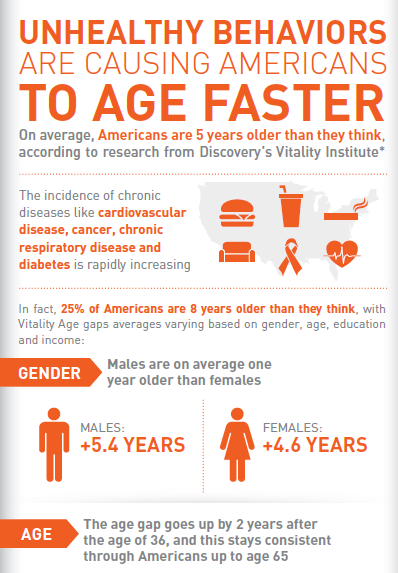We dont often think about aging in our youth. Afflictions of old age seem far off; something our grandparents deal with and therefore distant concerns we need not worry over. Yet years before age-related diseases become apparent, our bodies show signs of aging whether we realize it or not. On average, Americans are 5 years older than they think (see infographic below). Most aging research focuses on older adults, many already suffering from chronic diseases. Less focus has been placed on quantifying the gradual deterioration of organ systems among younger adults, even though that would be the time to take up healthy behaviors that help extend life and age in good health.
A recent study looked at over 1000 healthy young adults to test for variation in and the rate of change of aging. Results showed that young people of the same Chronological Age the age listed in their passports, and in this case, 38 years old varied greatly in their Biological Age, measured as a decline in the integrity of body organ systems, such as the immune system and cardiovascular system. Already, individuals who were aging more rapidly were less physically able, showed cognitive decline and brain aging, looked older, and self-reported worse health. Those who had an older Biological Age and also experienced a faster Pace of Aging scored lower on tests of balance, strength, motor coordination and IQ, and showed elevated risk for stroke and dementia.
This suggests that not only is aging quantifiable in younger people, but effects can already be seen on mental and physical function. Identification of accelerated aging before chronic disease develops offers greater opportunities for targeted preventive interventions.
New ways of highlighting this discrepancy and related health risks among younger age groups have been introduced such as Real Age, Lifetime risk and The Vitality Groups own Vitality Age*
Vitality Age is a medically and actuarially-derived tool used extensively throughout the US, UK and South Africa (where it was first developed) among members of the Vitality program. It presents you with a risk-adjusted age, based on health status and lifestyle habits. For those whose Vitality Age is higher than their chronological age, the Vitality program is a first of its kind to offer health interventions to close the gap. Young adulthood, before the onset of age-related chronic diseases, is the perfect time to act.
So what can you do to improve your Biological Age? Being physically active, eating well, avoiding tobacco, having preventive screenings, and taking care of your mental health are just some of the interventions throughout life that can improve both quality of life and longevity. Taking action today can help you live a better tomorrow.
Do you feel older or younger than your actual age? Whats your Vitality Age? How does your Vitality Age compare to those around you? What do you do to ensure that you are as healthy as possible as you inevitably age? Let us know by sharing in the comments below or tweeting at the Vitality Institute @VitalityInst.

Thumbnail image credit: OC Family & Wellness Center






